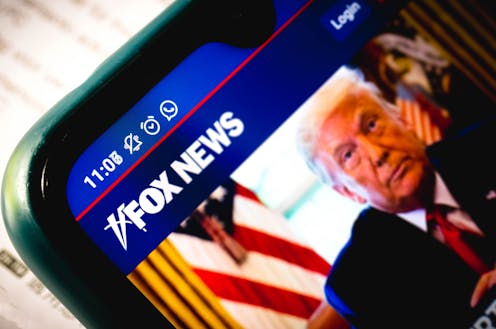Don't blame Fox News for the attack on the Capitol
- Written by Ashique KhudaBukhsh, Project Scientist at the School of Computer Science, Carnegie Mellon University

In the days following the attack on the Capitol, The New York Times, in its print edition, ran an op-ed titled “Yes, You Should Blame Fox For Whipping Up Radicals.” The Washington Post ran an article with the headline “Trump Couldn’t Have Incited Sedition Without the Help of Fox News[1].”
But our analysis tells a different story[2].
We studied the official YouTube channels of six U.S. cable news networks. We looked at cable news powerhouses CNN, Fox News and MSNBC. But we also focused on three fringe networks – Newsmax, One America News Network (OANN) and Blaze TV – that have a relatively homogeneous audience, relatively extreme opinions[3] and limited reach.
Our unique dataset – which consisted of all the comments made by viewers of those six networks from Nov. 3, the date of the presidential election, through Jan. 5, the day before the Capitol riots – showed that the fringe news networks were key players in the riots. And ironically, their outsize impact can be traced to Fox News’ controversial decision to call Arizona for Biden on election night[4].
Fox holds firm
Around 10 p.m. on Nov. 3 the Trump campaign was reportedly upbeat[5], having significantly outperformed the polls in Florida to win the state.
However, at 11:20 p.m. – with only 78% of the votes in Arizona counted – Fox News called[6] the Grand Canyon State for Biden. It would be days before any other network would do so, yet Fox News’ call significantly narrowed the odds of a Trump victory.
According to The New York Times[7], “what ensued … was a night of angry calls to Republican governors” and “a middle-of-the-night presidential briefing” with claims that the election was fraudulent. Trump then spent the next few days urging his base to abandon Fox in favor of Newsmax[8].
In the days and weeks that followed, Fox’s coverage of the election continued to be much more accurate in its reporting of the results than any of the three fringe news stations.
Drawing from the transcripts of the relevant videos, our research shows[9] that Fox was almost five times more likely to refer to Biden as “president-elect” than Newsmax from Nov. 3 to Jan. 5. In addition, drawing from the user comments during this entire time period, “stop the steal” was the 63rd most frequent three-word construct on Newsmax but only the 134th most frequent on Fox. In fact, Fox’s results on these measures were very similar to those of MSNBC and CNN.
This mode of reporting by Fox – along with Trump’s exhortations to his base to leave Fox for networks like Newsmax – seems to have had a swift and profound impact on the viewership of the fringe news networks.
Newsmax’s YouTube subscriber count increased over 300% in the two weeks following the election and stood at over 1.7 million subscribers by Jan. 5, compared with just over 200,000 at the end of August.
Conspiracies snowball in echo chambers
We can also compare how viewers responded to Newsmax’s content relative to Fox News’ content in terms of the ever-present social media currency of viewer “likes” and “dislikes.”
Those watching any of the YouTube newscasts can vote dislike or like. If the ratio of dislikes to the total number of impressions for a given video is, say, 0.4 – meaning 40 dislikes and 60 likes for every 100 impressions – we can conclude that it’s reaching a range of viewers, some of whom enjoy and agree with what they’re watching, and others who disagree with what they’re seeing.
For the period from the election to Jan. 5, this ratio was about 0.2 for both Fox News and CNN. In contrast, for Newsmax this ratio was between 0.01 and 0.02. In other words, for every 100 opinions on Newsmax videos, on average, only one or two dislikes surfaced, whereas for Fox, the number of dislikes, on average, exceeded 20.
There is no other way to interpret this: Newsmax viewers had fallen into an almost perfectly sealed echo chamber[10], in which commenters were reinforcing one another’s views with little to no pushback. One America News Network and Blaze TV showed very similar patterns in response to their content.
The hyperpartisan coverage on election integrity provided by Newsmax and others – combined with this echo chamber effect – makes them the more likely culprit for having riled up loyal Trump supporters.
Surely, these networks weren’t solely responsible for influencing those who stormed the Capitol. And we don’t deny that years of conspiracy theories promulgated by Fox[11] undoubtedly helped lay the groundwork for Trump’s base of support.
But in the days and weeks following the election, these fringe networks gave viewers a space to vent and disseminate misinformation that went largely unchallenged by others in their comments sections, as well as by the hosts of the news and opinion segments.
Fox found itself in uncharted waters: maligned by the far right for being relatively restrained and responsible.
References
- ^ Trump Couldn’t Have Incited Sedition Without the Help of Fox News (www.washingtonpost.com)
- ^ But our analysis tells a different story (arxiv.org)
- ^ relatively extreme opinions (arxiv.org)
- ^ controversial decision to call Arizona for Biden on election night (www.nytimes.com)
- ^ reportedly upbeat (www.nytimes.com)
- ^ Fox News called (www.nytimes.com)
- ^ According to The New York Times (www.nytimes.com)
- ^ urging his base to abandon Fox in favor of Newsmax (www.thetrumparchive.com)
- ^ our research shows (arxiv.org)
- ^ echo chamber (edu.gcfglobal.org)
- ^ years of conspiracy theories promulgated by Fox (doi.org)
Authors: Ashique KhudaBukhsh, Project Scientist at the School of Computer Science, Carnegie Mellon University
Read more https://theconversation.com/dont-blame-fox-news-for-the-attack-on-the-capitol-154047


